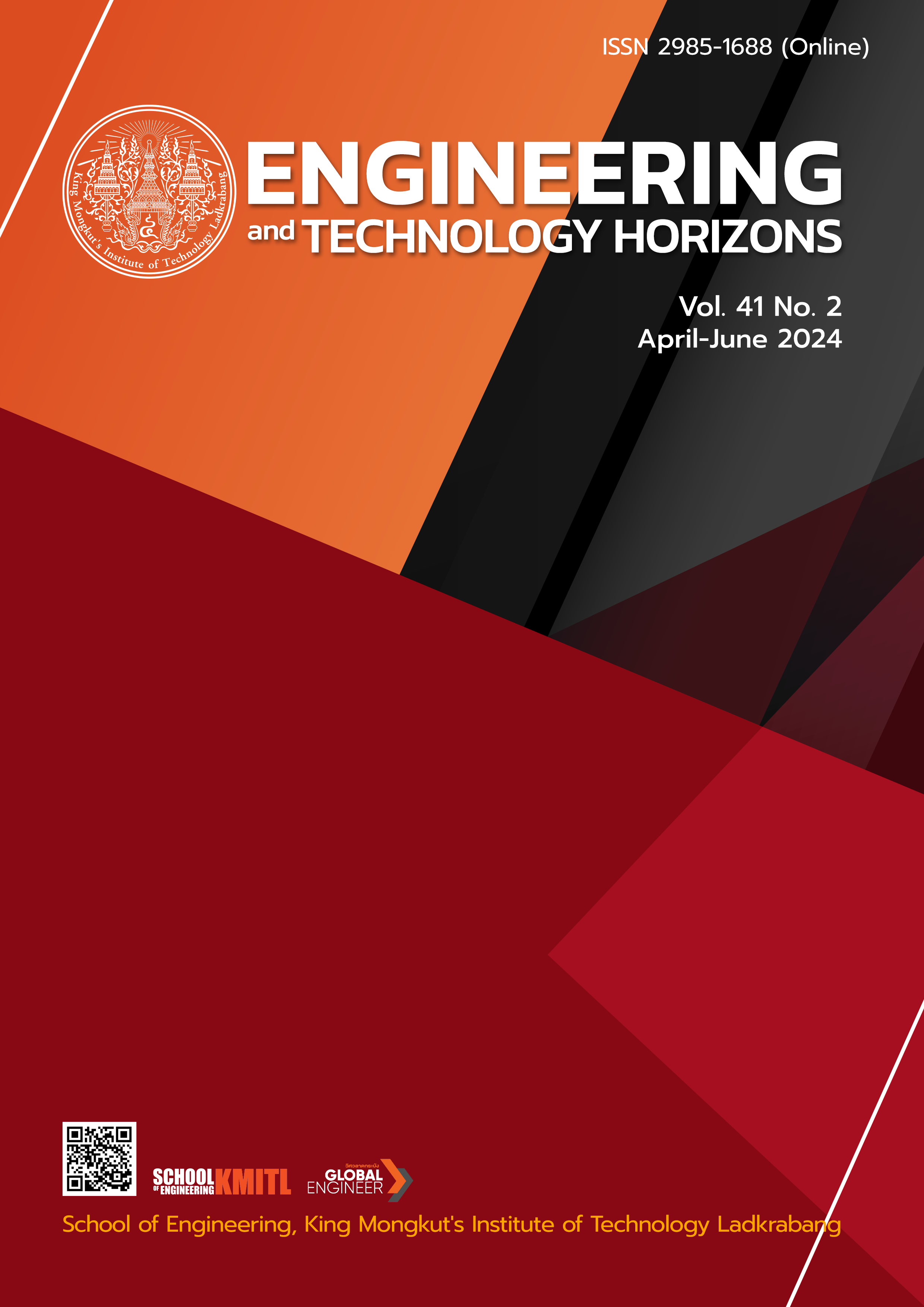Optimum Weight Parameter of Weight Centroid Method for Indoor Positioning in Environment with Different Path Loss Exponent and Multipath Fading Effect
DOI:
https://doi.org/10.55003/ETH.410206Keywords:
Weight centroid method, indoor positioning, path loss exponent, multipath fadingAbstract
This paper proposes optimum weight parameter of weight centroid method for indoor positioning in environment with different path loss exponent and multipath fading effect. The indoor environment is defined as square with each side 10 m long. There is a transmitter installed in the center of each side. The distance error model is applied to calculate the distances between the location coordinates of user and the location coordinates of transmitters in environment with different path loss exponent and multipath fading. The total 100 location coordinates of user are estimated by using weight centroid method, varying weight parameter in the range of 1 to 10. The optimum weight parameter is defined as the case where mean of distance error of all positions is the least. The optimum weight parameter for environment with different path loss exponent and multipath fading effect is illustrated. The results show that the optimum weight parameter changes slightly with the path loss exponent and tends to change with the standard deviation of the multipath fading effect divided into 3 periods. The first period tends to increase slowly, the second period tends to increase rapidly, and the third period tends to fluctuate up and down. Moreover, the size of the indoor environment has very little impact on the optimum weight parameter. These results make it possible to select optimum weight parameter for case with path loss exponent and standard deviation of multipath fading effect that match or are close to the channel of indoor environment.
References
M. Min, L. Xiao, J. Ding, H. Zhang, S. Li, M. Pan and Z. Han, “3D Geo-Indistinguishability for Indoor Location-Based Service,” IEEE Transactions on Wireless Communications, vol. 21, no. 7, pp. 4682–4694, 2022, doi: 10.1109/TWC.2021.3132464.
S. R. Garzon, T. Pöllabauer, S. Zickau and A. Küpper, “Interactive Design of Geofences for Proactive Location-based Services in Smart Cities,” in 2019 IEEE Smart World, Ubiquitous Intelligence & Computing, Advanced & Trusted Computing, Scalable Computing & Communications, Cloud & Big Data Computing, Internet of People and Smart City Innovation (Smart World/SCALCOM/UIC/ATC/CBDCom/IOP/SCI), Leicester, UK, Aug. 19–23, 2019, pp. 1184–1187.
J. Haifeng and W. Gin, “Design and implementation of location service based on signal strength difference,” in 2017 13th International Conference on Intelligent Environments, Seoul, South Korea, Aug. 21–25, 2017, pp. 1–5.
M. Qingmin, F. Tao, C. Chenyang, Z. Yulong and P. Fengmei, “A Campus Location Based Service Case for Mobile Virtual Network Operators,” in 2016 IEEE International Conference on Cloud Computing and Big Data Analysis, Chengdu, China, Jul. 5–7, 2016, pp. 215–220.
R. Filjar, M. Ševrović and Dadić, “Positioning and localization for Location-based services,” in 21st Telecommunications forum TELFOR, Belgrade, Serbia, Nov. 26–28, 2013, pp. 9–12.
Z. Zhou, M. Li and B. Long, “A Review of Mission Critical Service over Proximity based Service,” in 2023 IEEE/CIC International Conference on Communications in China, Dalian, China, Aug. 10–12, 2023, pp. 1–6.
F. Zafari, I. Papapanagiotou, M. Devetsikiotis and T. J. Hacker, “Enhancing the Accuracy of iBeacons for Indoor Proximity-based Services,” in 2017 IEEE International Conference on Communications, Paris, France, May. 21–25, 2017, pp. 1–7.
J. E.-Sobhy, S. Zickau and A. Küpper, “Proximity-based Services in Mobile Cloud Scenarios Using Extended Communication Models,” in 2015 IEEE 4th International Conference on Cloud Networking, Ontario, Canada, Oct. 5–7, 2015, pp. 125–131.
K. W. Choi and Z. Han, “Device-to-Device Discovery for Proximity-Based Service in LTE-Advanced System,” IEEE Journal on Selected Areas in Communications, vol. 33, no. 1, pp. 55–66, 2015, doi: 10.1109/JSAC.2014.2369591.
Y.-H. Tsai, Y.-T. Lin, K. C. Loa, T.-Y Tsai, C.-C Chien, D.-C Huang, S.-T. Sheu and P.-S Kao, “Proximity-based Service Beyond 4G Network: Peer-aware Discovery and Communication Using E-UTRAN and WLAN,” in 2013 12th IEEE International Conference on Trust, Security and Privacy in Computing and Communications, Victoria, Australia, Jul. 16–18, 2013, pp. 1345–1350.
K. Liu and X. Li, “Overview of Mobile Systems,” in Mobile SmartLife via Sensing, Localization, and Cloud Ecosystems, 1st ed. Boca Raton, FL, USA: CRC Press, 2020, ch. 2, sec. 2.1, pp. 12.
T. S. Rappaport, “Mobile Radio Propagation: Large-Scale Path Loss,” in Wireless Communications: Principles and Practice, 2nd ed. Upper Saddle River, NJ, USA: Pentice Hall PTR, 2002, ch. 3, sec. 3.2, pp. 70–74.
S. Sadowski and P. Spachos, “RSSI-Based Indoor Localization With the Internet of Things,” IEEE Access, vol. 6, pp. 30149–30161, 2018, doi: 10.1109/ACCESS.2018.2843325.
F. Zafari, I. Papapanagiotou and K. Christidis, “Microlocation for Internet-of-Things-Equipped Smart Buildings,” IEEE Internet of Things Journal, vol 3, no. 1, pp. 96–112, 2016, doi: 10.1109/JIOT.2015.2442956.
P. Supanakoon and S. Promwong, “Evaluation of Distance Error with Bluetooth Low Energy Transmission Model for Indoor Positioning,” Journal of Mobile Multimedia, vol. 17, no. 4, pp. 707–722, 2021, doi: 10.13052/jmm1550-4646.17411.
Downloads
Published
How to Cite
Issue
Section
License
Copyright (c) 2024 School of Engineering, King Mongkut’s Institute of Technology Ladkrabang

This work is licensed under a Creative Commons Attribution-NonCommercial-NoDerivatives 4.0 International License.
The published articles are copyrighted by the School of Engineering, King Mongkut's Institute of Technology Ladkrabang.
The statements contained in each article in this academic journal are the personal opinions of each author and are not related to King Mongkut's Institute of Technology Ladkrabang and other faculty members in the institute.
Responsibility for all elements of each article belongs to each author; If there are any mistakes, each author is solely responsible for his own articles.






